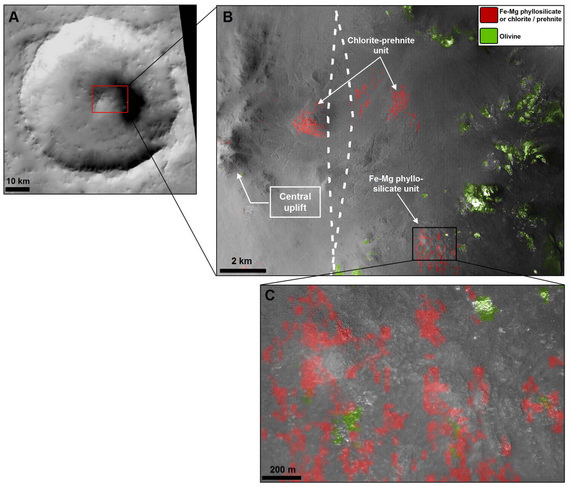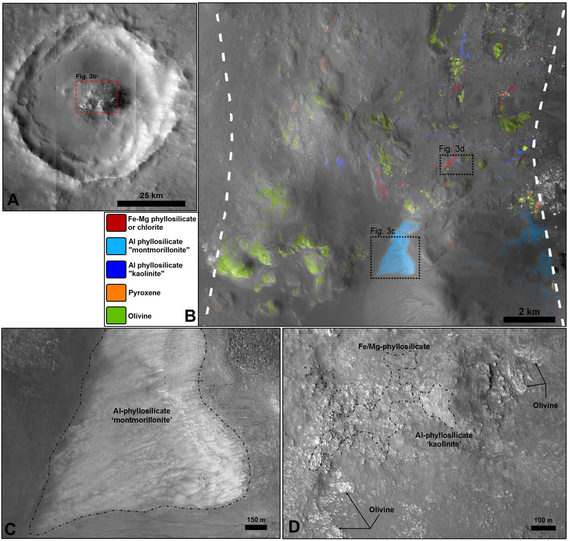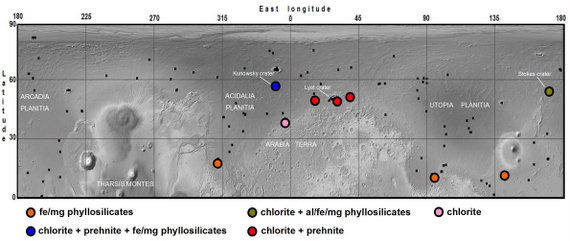By looking at the mineralogy deep inside craters on Mars’ northern plains and comparing it to the makeup of regions in the southern hemisphere, scientists have found that widespread liquid water likely altered the majority of Red Planet’s crust about 4 billion years ago. However, the new findings do not support other recent studies that suggest a giant ocean covered Mars’ northern highlands.
Using the Mars Express OMEGA instrument and the Mars Reconnaissance Orbiter’s CRISM instrument, John Carter from Bibring at Université Paris in Orsay, France along with a group of scientists from France and the US, investigated large craters and found minerals which could have only formed in the presence of water. “We’ve detected hydrated minerals in about 10 of these craters,” Carter told Universe Today, “and we conclude that the ancient crust was altered in a similar way both in the south and in the north, in a very early environment which was much warmer and wetter than today’s.”
Carter added that in terms of Mars’ water history, this means liquid water existed near and on the surface of early Mars on a planetary scale, and is not restricted to select areas of the southern highlands.
Mars has dichotomy between north and south, (read our earlier article “The Two Faces of Mars Explained) so while the south is ancient, heavily cratered and high up, the north is smooth, with low-lying plains. It also is much younger and less cratered than the south. This is due to a volcanic mantling processes which filled up part of the lowlands and thus erased any former structures.

Carter and his team began their work based on studies of hundreds of sites in the southern hemisphere of Mars which were found to have hydrated minerals which formed on or near the surface some 4 billion ago in a wet and warm environment. While today Mars does not and cannot sustain liquid water on its surface, the scientists knew that a rather weak hydrological system had existed in the southern hemisphere, based on previous geological and morphological evidence.
If minerals in Mars’ northern hemisphere had formed in the presence of water, those minerals would have been buried by the widespread and intense lava flow which happened about 3 billion years ago, resurfacing that region of the planet. But looking into impact craters provides a window into Mars’ past by penetrating down through the lava flow, as well as showering chunks of the underlying crust across the nearby surface.
Carter said the data from OMEGA and CRISM show the mineral assemblages within and around these craters in the north as are very similar to what is seen in the southern ancient highlands, which includes phyllosilicates or other hydrated silicates.
“Our work broadens our view of liquid water on ancient Mars,” Carter said in an email, “spreading it to most of the planet, and may also provide a constraint on the timing of the northern hemisphere alteration with respect to its formation.”
Another conclusion, Carter said, is that these detections may be a constraint on when Mars could have possibly been conducive to the formation of life. “The main scenario which explains the dichotomy is that of an oblique impact between Mars and a fair sized celestial body, thus obliterating and re-melting a great deal of the northern hemisphere of Mars. Such an impact would surely have destroyed any pre-existing hydrated minerals at the depths at which we’re seeing them or we think they come from. Thus the water stability era likely took place after this giant impact, and did not last long (several hundred million years at most). Thus our work may provide a lower limit on this era.”

Concerning the giant ocean scenario for the northern highlands, on which a paper was published just last week, Carter said his team’s findings show evidence against those circumstances. “Previous work by a number of teams have actually shown the unlikelihood of a giant northern ocean on Mars younger than 3 billion years as hypothesized by several researchers,” he said. “There is no morphological nor mineralogical evidence for such an ocean. In our 10 or so craters of the northern plains of Mars where we found hydrated minerals, we also found mafic minerals such as olivine. This olivine is almost ubiquitous in northern plain craters, and the vast majority of it is unaltered. Olivine is very readily altered by liquid water hence a giant ocean which would have submerged all these craters should have altered all the olivine, and this is seldom the case.”
Carter said that studying craters from orbit provides a bit of a challenge. “It is hard, for example, to distinguish rocks from orbit which may have been excavated by the impact or actually formed after the impact when the heat released and the existing water and/or ice interacted with the rock to form new minerals, creating hydrothermal environments. In our paper we put forward several reasons why an excavation scenario is favored to a post-impact hydrothermal scenario.”
But craters on Mars provide a better study of the past than craters on Earth, since craters may exist on Mars for billions of year without much degradation, while on Earth water, tectonics and plant growth all conspire to conceal and change craters. Carter said the excavated material on Mars will not be altered by the current ultra-dry, cool environment on the Red Planet.
This research new appears in the June 25, 2010 issue of Science.
Sources: AAAS/Science, email exchange with John Carter


@ jearley:
That article discusses McKay et al papers 2009 (Geochimica et Cosmochimica Acta, SPIE Proceedings).
The first paper claims that they have eliminated all non-biological explanations based on thermal (or shock) decomposition. However, as if to answer them the same year this paper by Niles et al appeared in Earth and Planetary Science Letters and introduced a new low-temperature scenario that AFAIU undermines the earlier paper’s conclusion.
The SPIE paper adds Nakla and Yamato 000593 biomorphs to ALH84001. It is beyond a paywall, so I can’t get to it. However the use of morphology alone, or even together with chemical analysis, has been problematic for Earth microfossils, for instance, as in Schopf “Fossil evidence of Archaean life” (2006) as critiqued by Brasier et al in “A fresh look at the fossil evidence for early Archaean cellular life” (2006).
In short, there is nothing new there AFAIU. The consensus on ALH84001 (and the other Martian meteorites) remain AFAIU that there is no unambiguous test for life.
Interesting; but also difficult to follow the different age scenarios for last great impactor, oceans and crater record, so at a guess there are simple dating scenarios that glue these observations together. (For example, I can’t remember that the ocean scenario reached 3 Ga; indeed the UT article mention 3.5 Ga.)
Another prediction is that IVAN3MAN will get a literary orgasm when he starts to edit the article. [No, not a literal orgasm, you dirty minds. This is supposed to be a SFW blog, right?]
Among the several funny sentences and words my personal favorite was “geologocial” (end of 4th paragraph) which is less “logical” than the term I’m used to. 😀
Does anyone besides me think that it is totally cool that the author of the report was JOHN CARTER?
Maybe I am just old…
(if you miss the reference, look up Edgar Rice Burroughs)
I would imagine the Martian atmosphere was much heavier 4 billion years ago if water was able to exist. What does this portend for the existence of life on Mars at that time?
William 928:
You are correct. The atmospheric pressure on Mars must have been higher, and the surface warmer that today’s cold, dry terrain.
The Martian meteorites that have been analyzed for traces of life have all been quite old, AFAIK, and the investigators are apparently certain that there are life indicators present in (the last time I looked at the literature) three of the meteorites. It is my understanding that the current consensus among those investigators is that there was primitive live on Mars 2GYA.
Hers is an article from 2009:
http://www.timesonline.co.uk/tol/news/science/space/article6934078.ece
… maybe I should say that the consensus _aught to_ remain the same, since as a layman I’m not privy to the latest developments.
Oceans as we think of them on Earth are associated with a basaltic and granitic system with tectonics. The very early Earth probably had a lot of water, but lacked oceans as we think of them.
Yes the martian atmosphere was much thicker back then.
LC
Duh! “ought to”.
@ LBC:
And conversely, the granitic eutectic that drives convective wise efficient plate tectonics has a difficult time to exist without water priming it. It’s a conundrum.
One suggestion has been for an early world wide ocean covering the first type of (non-granitic) rock, until tectonics got started by enough low density stuff stacking up to make the first continental plates. (Possibly by oceanic plates being forced under to make the first “dominant raft” plate.)
In such a scenario the very same primordial ocean and the atmosphere above can be huge sources of organics, as methane can be released by the underlying igneous chemistry.